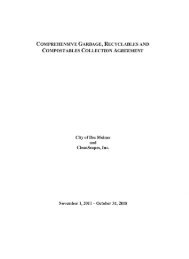CITY OF DES MOINES SHORELINE MASTER PROGRAM
CITY OF DES MOINES SHORELINE MASTER PROGRAM
CITY OF DES MOINES SHORELINE MASTER PROGRAM
You also want an ePaper? Increase the reach of your titles
YUMPU automatically turns print PDFs into web optimized ePapers that Google loves.
Des Moines Shoreline Master Program<br />
4.5 Restoration Opportunities<br />
When identifying, evaluating, and prioritizing opportunities for restoration, the concept of<br />
“restoration” in the context of SMP planning should be linked to two key concepts:<br />
1. Restoration or enhancement should support the overarching goal that local SMPs “serve<br />
to improve the overall condition of habitat and resources within the shoreline area”; and<br />
2. Restoration should be designed to address areas where shoreline ecological functions<br />
have been impaired as a result of past development activities.<br />
Both programmatic and site-specific opportunities for shoreline restoration or enhancement exist<br />
in Des Moines. Opportunities have been identified by both regional plans (e.g., WRIA 9 Salmon<br />
Habitat Plan and related studies) and the City’s Shoreline Inventory and Characterization<br />
(Adolfson, 2005).<br />
4.5.1 Programmatic Opportunities<br />
The WRIA 9 Salmon Habitat Plan recommends development of several programs relevant to the<br />
City of Des Moines SMP update. The programs would be developed by King County in<br />
coordination with local jurisdictions and could be implemented at the local level by the County<br />
or by the City of Des Moines. These include:<br />
• Promote Habitat Restoration on Private Property by Offering a “Toolbox” of Nearshore<br />
Habitat Project Designs. This program would promote voluntary restoration on private<br />
property by creating a “toolbox” of model habitat design and shoreline restoration<br />
actions. Types of actions could include removal of unneeded shoreline armoring and/or<br />
derelict structures, and rehabilitation of marine riparian vegetation. The program would<br />
provide technical assistance to landowners and would seek to develop incentives to<br />
encourage voluntary restoration projects on private property.<br />
• Create a Soft Armoring Technical Assistance and Cost-Share Program. This program<br />
would promote voluntary replacement of traditional “hard” shoreline armoring<br />
(concrete/riprap/wooden bulkheads) with “soft-shore” armoring techniques where<br />
appropriate and feasible. Specific designs would vary from site to site depending on the<br />
site’s unique characteristics. A number of case studies and example designs are<br />
provided in Alternative Bank Protection Methods for Puget Sound Shorelines (Ecology,<br />
2000). An area in Des Moines that would most directly benefit from this type of<br />
program is the Woodmont Neighborhood. Much of the shoreline in this neighborhood is<br />
privately owned with a majority being developed single-family residential areas and<br />
local streets. However, public education or incentives for shoreline bulkhead removal<br />
could help restore natural shoreline processes in this formerly important reach of feeder<br />
bluff (Adolfson, 2005), as well as at other sites.<br />
• Citizen Volunteer Forage Fish Monitoring Program. This program would offer an<br />
opportunity for citizens to work with biologists and participate in data gathering to better<br />
identify and monitor forage fish spawning areas.<br />
Department of Ecology approval effective November 1, 2010<br />
38 Adopted by City of Des Moines Ordinance No. 1502



